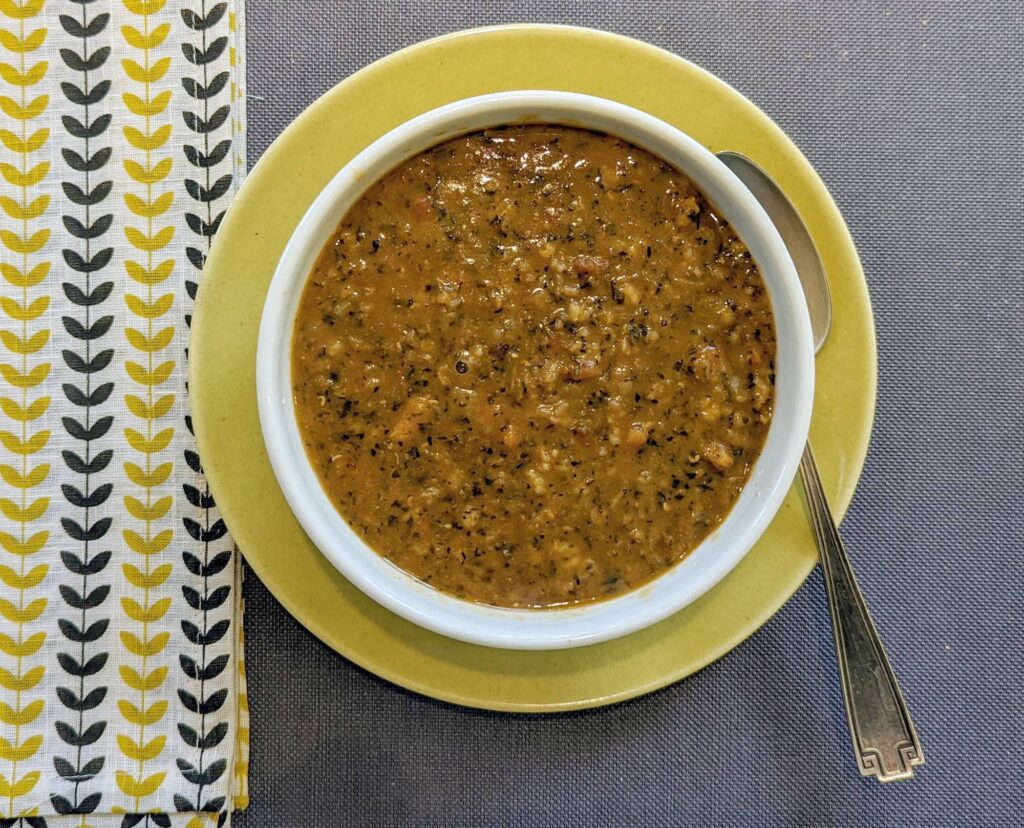
A small tuxedo-clad orchestra doesn’t serenade us when we eat Hungarian gulyás soup at home. Too bad. It was a nice touch when we tasted our first authentic Magyar version of the dish in Budapest at the legendary Gundel restaurant (HU-1146, Gundel Károly út 4., Budapest; +36 30 603 2480; gundel.hu). Often bastardized as ‶goulash,″ gulyás (pronounced GOO-yash) has been the country’s national dish since the early 19th century. That designation was made to differentiate Hungarian cuisine from the Austrian cooking of their oppressors of the moment.

The soup’s historic roots offer a nice international analogy to the chile con carne of Texas. Magyar herdsmen would spice, cook, and dry the flesh of lean cows culled from their herds and pack the meat into their saddlebags with onions, bacon, and root vegetables. When they made camp, a warm meal was close at hand. When peppers arrived from the Americas via Turkish invaders in the 16th century, Hungarian paprika was born. The final piece for modern gulyás was in place.
A proper Hungarian version of the soup (it should never be flour-thickened like a stew) uses copious quantities of paprika as well as caraway seeds and equal volumes of onions and cubed meat, usually beef. In addition to the usual carrots and potatoes, many Hungarian-Americans like to add parsnips. The finishing touch, however, is the addition of pinched egg noodles, called csipetke.
Our version below was adapted from a variety of sources, including two rather different recipes that both purported to represent the Gundel restaurant’s gulyás and another from a now-vanished Budapest luxury hotel. Actually, as a peasant dish, gulyás doesn’t call for fancy ingredients, special equipment, or tricky technique. It just takes time.
HUNGARIAN GULYÁS SOUP
Taking a leaf from the Gundel presentation of the soup, we recommend steaming the vegetables and boiling the noodles separately so they maintain their structural integrity. Add them to the soup shortly before serving. This recipe makes four hearty bowls—excellent by itself or with fresh bread and a small green salad.

INGREDIENTS
- 2 tablespoons oil or lard
- 4 oz. bacon, diced
- 3 medium onions, quartered and thinly sliced
- 1 teaspoon salt
- 1/4 cup sweet Hungarian paprika
- 1/2 teaspoon black pepper
- 1 tablespoon caraway seeds
- 6 cloves garlic, finely minced
- 2 lb. beef, cut into 1/2-inch cubes
- 6 cups beef broth
- 2 tomatoes, diced (or a 14 oz. can of diced tomatoes)
- 2 medium carrots, sliced into bite-sized rounds
- 4 medium large potatoes, cubed
- 1 recipe csipetke (see below)
DIRECTIONS
In a 5-quart Dutch oven, heat oil or lard and add bacon. Cook very slowly to render out the fat. Set cooked bacon aside and add the onions and salt. Stir well and continue cooking slowly for 15-20 minutes. The onions should practically melt but not brown.
In a large bowl, combine paprika, black pepper, caraway seeds, and minced garlic. Add beef and toss to coat. Turn the heat up to high under the Dutch oven, add the spiced beef, and cook until it browns. Turn down the heat, add a few tablespoons of broth to deglaze, and cook about 15 minutes until beef is pink in the middle. Add remaining broth and cook over low heat for an hour or more—until the meat is nearly tender enough to serve.
While the meat is cooking, steam the carrots and potatoes about 10 minutes and set aside. Add more water to the steaming pot and add salt until water tastes like the sea. Bring to a boil while preparing the csipetke dough.
About 15 minutes before serving, add vegetables and noodles to soup and bring to a simmer. Taste and adjust the seasoning with salt and pepper.
Serve using a slotted spoon to pile the solids high in the soup bowl. Then fill the bowl with broth.
CSIPETKE
Super-easy to make, ‶csipetke″ means ‶pinched noodle.″ Once you’ve made the dough, pinch off pieces about the size of a dime between thumb and forefinger. Roll them into balls, then pinch flat before dropping into the boiling salted water to cook.
INGREDIENTS
- 1 large egg, beaten
- 2 tablespoons water
- 1/4 teaspoon salt
- 1/2 cup flour, plus more for kneading
DIRECTIONS
Mix together the egg, water, and salt in a medium-size bowl. Stir in the flour and mix into stiff batter. Knead with fingertips to form a smooth, firm dough. Wrap with plastic wrap and let sit for 10 minutes or more for the flour to absorb and disperse the moisture.
Pinch off pieces of dough, roll, then flatten and drop them into the boiling salted water. Cook for 15 minutes, or until tender. The irregular shapes are part of dish’s rustic charm.
